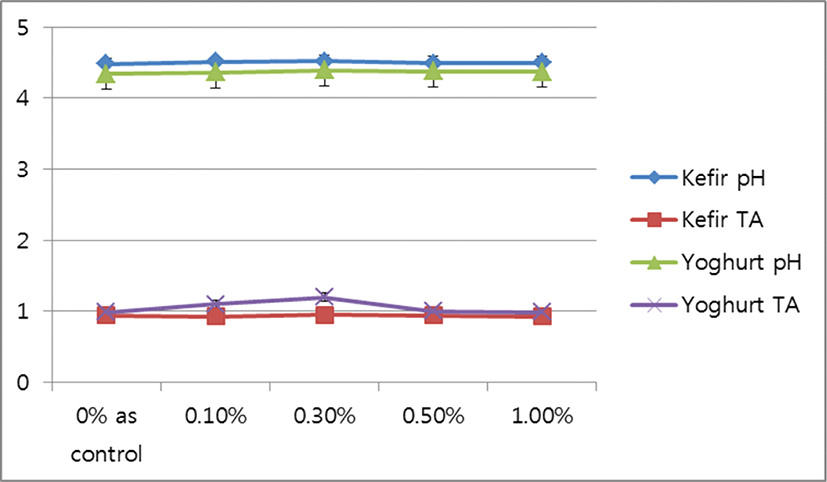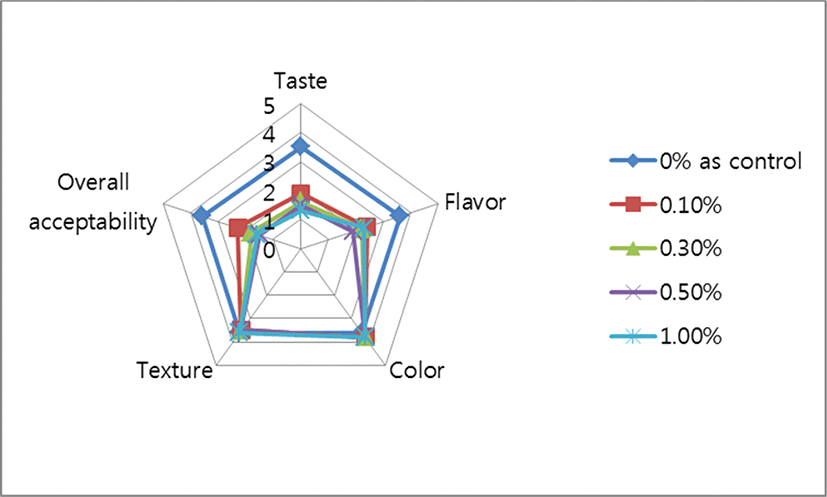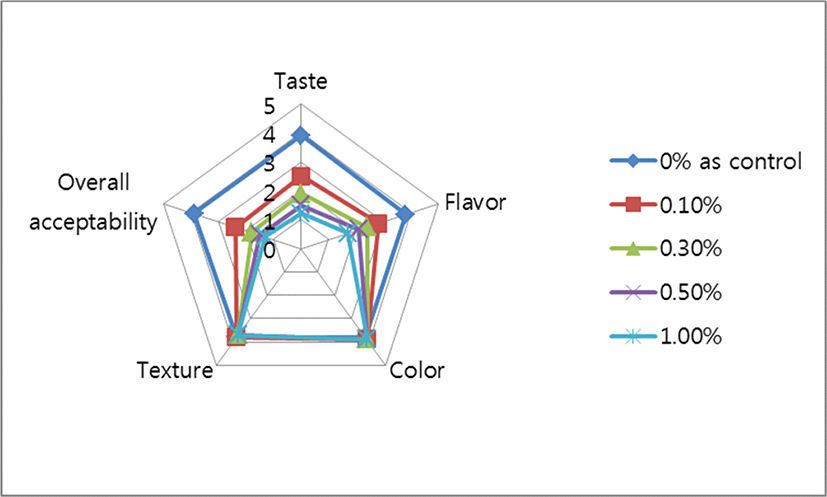Introduction
Mentha piperita L. and its extracts have been used for the treatment of various diseases for a long time (Alankar, 2009; Lim et al., 2018). Especially, Mentha piperita L is widely known as peppermint or mint (Lim et al., 2018). According to many recent studies, various effects of Mentha piperita L have been found in cancer, diabetes, asthma, heart problems, and so on (Mucciarelli et al., 2007; Cash et al., 2016; Lim et al., 2018). Especially, the recently most widely produced and consumed essential oil is peppermint oil (Loolaie et al., 2017; Lim et al., 2018). Furthermore, peppermint oil could show the excellent antimicrobial activity against food poisoning bacteria and pathogenic bacteria, and peppermint oil is also widely used as a food additive (Cash, 2015; Schmitz et al., 2015; Lim et al., 2018). Hence, it is possible for the application of Mentha piperita’s (peppermint) oil to add directly to various dairy products for improving both the sensory attributes and nutritional property of the final product.
Therefore, the purpose of this study was to manufacture Kefir and Yogurt added with Mentha piperita’s (peppermint) oil with improving the organoleptic profiles. In this experiment, among several categories of quality in Kefir and Yogurt produced with Mentha piperita’s (peppermint) oil, organoleptic profiless were analyzed.
Materials and Methods
The oil of Mentha piperita’s (peppermint) was produced by Borak Company (Korea) and was purchased from Serim Food Company (Korea), respectively. In this study, Mentha piperita’s (peppermint) oil was 100% purity as the food additive grade.
The Kefir grains obtained from Center for KU Food Safety (College of Veterinary Medicine, Konkuk University in Seoul, Korea), and also were applied for fermenting milk to manufacture Kefir (Jeong et al., 2017). Kefir samples were added with different concentration of Mentha piperita’s (peppermint) oil (control as 0%, 0.1%, 0.3%, 0.5%, and 1.0%), and then The final Kefir products were kept at 4±0.5°C.
The oil of Mentha piperita’s (peppermint) was added to Yogurt premix at concentrations of 0% (control), 0.1%, 0.3%, 0.5%, and 1.0%, and then mixed thoroughly (Jeong et al., 2017). A commercial Yogurt starter culture Lyofast YAB 450AB (Sacco srl., Codaragok, Italy) were inoculated and fermented for 5 h, and then the final Yogurt products were kept around 4±1°C for 24 h.
According to method of Jeong et al. (2017), the pH and TA (titratable acid) of Kefir and Yogurt was analyzed by the pH meter (Orion Star A211, USA) and by titration with 0.1 N NaOH, respectively.
The organoleptic profiles were investigated by fifteen panelists between 20 and 50 years of age. The samples coded with three digit numbers were randomly prepared in disposable plastic cups (10±0.5 mL) at 10±1°C. All assessors completed a test assessment form to compare the five organoleptic profiles (taste, color, flavor, texture, and overall acceptability) using the five-point hedonic scale (5, excellent; 4, good; 3, fair; 2, poor; 1, extremely poor). All panelists participated in the organoleptic profiles of this study after hearing and agreeing to it fully.
GraphPad Prism 5 (GraphPad Softward Inc., San Diegeo, CA, USA) as statistical software was used for analyzing all data which obtained from two separate experiments with triplicate assays. All data were expressed as means±standard deviation. Statistical significance was considered at p<0.05.
Results and Discussion
In general, pH was high depending on the increase of TA. The pH of Kefir and Yogurt was decreased to around 4.48–4.51 and 4.33–4.39, respectively, and also the TA of Kefir and Yogurt was increased to around 0.93%–0.95% and 0.98%–1.12%, respectively (Fig. 1). In this study, the pH and TA value of Kefir and Yogurt added with Mentha piperita’s (peppermint) oil (0.1%, 0.3%, 0.5%, and 1.0%) showed similar to that of Kefir and Yogurt added with Mentha piperita’s (peppermint) oil (control as 0%) (Fig. 1). Hence, there was not any statistical difference of pH and TA of Kefir and Yogurt between control group and treated group. The results of this experiment showed a similar trend with the results of other experiments (Jeong et al., 2017).

The organoleptic profiles of Kefir were evaluated by 15 trained panelists of ages 20 to 50 years, and the results are summarized in Fig. 2. Kefir was prepared with Mentha piperita’s (peppermint) oil at concentrations of 0%, 0.1%, 0.3%, 0.5%, and 1.0%, respectively. According to statistical analysis of the organoleptic profiles, there was not any statistical difference in flavor and texture, but in taste, color and overall acceptability between control group and treated group (p<0.05).

The scores of taste in Kefir with Mentha piperita’s (peppermint) oil (control as 0%, 0.1%, 0.3%, 0.5%, and 1.0%) showed 3.5, 1.9, 1.6, 1.5, and 1.3, respectively. The scores of color in Kefir with Mentha piperita’s (peppermint) oil (control as 0%, 0.1%, 0.3%, 0.5%, and 1.0%) showed 3.6, 2.4, 2.2, 1.9, and 2.3, respectively. The scores of flavor in Kefir with Mentha piperita’s (peppermint) oil (control as 0%, 0.1%, 0.3%, 0.5%, and 1.0%) showed 3.6, 3.8, 3.8, 3.8, and 3.8, respectively. The scores of texture in Kefir with Mentha piperita’s (peppermint) oil (control as 0%, 0.1%, 0.3%, 0.5%, and 1.0%) showed 3.6, 3.5, 3.5, 3.5, and 3.6, respectively. And the scores of overall acceptability in Kefir with Mentha piperita’s (peppermint) oil (control as 0%, 0.1%, 0.3%, 0.5%, and 1.0%) showed 3.6, 2.3, 1.8, 1.5, and 1.6, respectively.
Consequently, among the treated group compared with the control group (0%), the scores of taste, color and overall acceptability were the same or lower in Mentha piperita’s (peppermint) oil-containing Kefir with 0.1%, 0.3%, 0.5%, and 1.0%.
The Yogurt was prepared with Mentha piperita’s (peppermint) oil at concentrations of 0%, 0.1%, 0.3%, 0.5%, and 1.0%, respectively, and the results are summarized in Fig. 3. The scores of taste in Yogurt with Mentha piperita’s (peppermint) oil (0.1%, 0.3%, 0.5%, and 1.0%) ranged from 2.5 points to 1.2 point, which were lower than those of Yogurt added with Mentha piperita’s (peppermint) oil (control as 0%) (3.9 points). The scores of color in Yogurt with Mentha piperita’s (peppermint) oil (0.1%, 0.3%, 0.5%, and 1.0%) ranged from 2.8 points to 1.7 point, which was comparable to those of Yogurt added with Mentha piperita’s (peppermint) oil (control as 0%) showed 3.8 points. The scores of flavor in Yogurt with Mentha piperita’s (peppermint) oil (0.1%, 0.3%, 0.5%, and 1.0%) ranged from 3.9 points to 3.89 point, whereas those of Yogurt added with Mentha piperita’s (peppermint) oil (control as 0% ) showed 3.8 points. The scores of texture in Yogurt with Mentha piperita’s (peppermint) oil (0.1%, 0.3%, 0.5%, and 1.0%) ranged from 3.8 points to 3.7 point, whereas those of Yogurt added with Mentha piperita’s (peppermint) oil (control as 0%) showed 3.8 points. And the scores of the overall acceptability decreased with increasing amounts of added Mentha piperita’s (peppermint) oil. Among the treated group, the high scores were received by Mentha piperita’s (peppermint) oil-containing Yogurt with 0.1% compared with the control group (0%). To summarize the results, the scores of the taste, color and overall acceptability decreased in proportion to the added amount of Mentha piperita’s (peppermint) oil.

In general, the characteristics of Mentha piperita’s (peppermint) oil has been used for improving food’s texture and physical properties, for increasing food’s viscosity and stickiness, and for enhancing food’s emulsion stability (Shams et al., 2015; Lim et al., 2018). Especially, Mentha piperita’s (peppermint) oil is mainly used as a thickener in foods (Baliga and Rao, 2010). This study also showed that the addition of Mentha piperita’s (peppermint) oil did not affect the organoleptic profiles of taste and texture in Kefir and Yogurt. Hence, further research in this area will be carried out.






